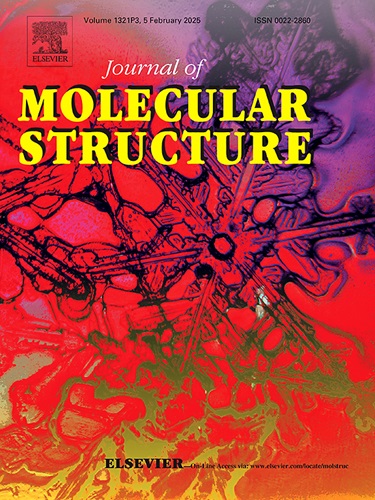Crystal structure, Hirshfeld surface analysis, thermal behavior and spectroscopic investigations (FT-IR and CP-MAS NMR)) of a new organosulfate, [C6H22N4]4+(SO42−)(HSO4−)2
IF 4
2区 化学
Q2 CHEMISTRY, PHYSICAL
引用次数: 0
Abstract
Crystals of a new organosulfate, [C6H22N4]4+(SO42−)(HSO4−)2 I were prepared at room temperature by slow evaporation. Suitable crystals have been subjected to X-ray diffraction, TG-DTA, IR and NMR spectroscopy accomplished with DFT calculation. The results of these investigations are discussed. The combination of N,N'-Bis(2-aminoethyl)ethane-1,2-diamine with sulfuric acid was confirmed by FT-IR studies using a Nicolet IR200 FT-IR spectrometer in the range 4000-400 cm−1. The crystal data of the title compound were collected by subjecting the grown samples to single crystal XRD and the study reveals that the organosulfate is triclinic and it belongs to P space group. The calculated lattice parameter values are a = 9.3851(2), b = 11.5963(3), c = 16.2294(4) Å, α = 102.0600(10), β = 101.4790(10), γ = 98.8180(10) °, Z = 4 and V = 1657.39(7) Å3. From the structural investigation, it is found that the studied compound is built by trimers resulting from the association of SO42− and HSO4− anions through O-H…O hydrogen bonds to form rows propagating along the b direction. The tetracations connect these rows via N-H...O hydrogen bonds and C-H...O interactions to create a three-dimensional framework. From the infrared spectroscopy analysis, the functional groups were identified. Simultaneously, the thermal behavior, NMR spectroscopy and Hirshfeld surface analyses were also elucidated.
新型有机硫酸盐[C6H22N4]4+(SO42−)(HSO4−)2的晶体结构、Hirshfeld表面分析、热行为和光谱研究(FT-IR和CP-MAS NMR)
采用室温慢蒸发法制备了新型有机硫酸盐[C6H22N4]4+(SO42−)(HSO4−)2 I晶体。对合适的晶体进行了x射线衍射、TG-DTA、IR和NMR分析,并进行了DFT计算。讨论了这些研究的结果。N,N'-双(2-氨基乙基)乙烷-1,2-二胺与硫酸的结合用Nicolet IR200 FT-IR光谱仪在4000-400 cm−1范围内进行了FT-IR研究。通过对生长样品进行单晶XRD分析,获得了标题化合物的晶体数据,研究表明该有机硫酸盐为三斜晶,属于P1¯空间群。计算得到的晶格参数值为a = 9.3851(2), b = 11.5963(3), c = 16.2294(4) Å, α = 102.0600(10), β = 101.4790(10), γ = 98.8180(10)°,Z = 4, V = 1657.39(7) Å3。通过结构分析发现,所研究的化合物是由SO42 -和HSO4 -阴离子通过O- h…O氢键结合形成沿b方向传播的三聚体构成的。牵引通过N-H连接这些行…O氢键和碳氢键…O相互作用来创建一个三维框架。通过红外光谱分析,确定了其官能团。同时对其热行为、核磁共振光谱和赫希菲尔德表面分析进行了分析。
本文章由计算机程序翻译,如有差异,请以英文原文为准。
求助全文
约1分钟内获得全文
求助全文
来源期刊

Journal of Molecular Structure
化学-物理化学
CiteScore
7.10
自引率
15.80%
发文量
2384
审稿时长
45 days
期刊介绍:
The Journal of Molecular Structure is dedicated to the publication of full-length articles and review papers, providing important new structural information on all types of chemical species including:
• Stable and unstable molecules in all types of environments (vapour, molecular beam, liquid, solution, liquid crystal, solid state, matrix-isolated, surface-absorbed etc.)
• Chemical intermediates
• Molecules in excited states
• Biological molecules
• Polymers.
The methods used may include any combination of spectroscopic and non-spectroscopic techniques, for example:
• Infrared spectroscopy (mid, far, near)
• Raman spectroscopy and non-linear Raman methods (CARS, etc.)
• Electronic absorption spectroscopy
• Optical rotatory dispersion and circular dichroism
• Fluorescence and phosphorescence techniques
• Electron spectroscopies (PES, XPS), EXAFS, etc.
• Microwave spectroscopy
• Electron diffraction
• NMR and ESR spectroscopies
• Mössbauer spectroscopy
• X-ray crystallography
• Charge Density Analyses
• Computational Studies (supplementing experimental methods)
We encourage publications combining theoretical and experimental approaches. The structural insights gained by the studies should be correlated with the properties, activity and/ or reactivity of the molecule under investigation and the relevance of this molecule and its implications should be discussed.
 求助内容:
求助内容: 应助结果提醒方式:
应助结果提醒方式:


